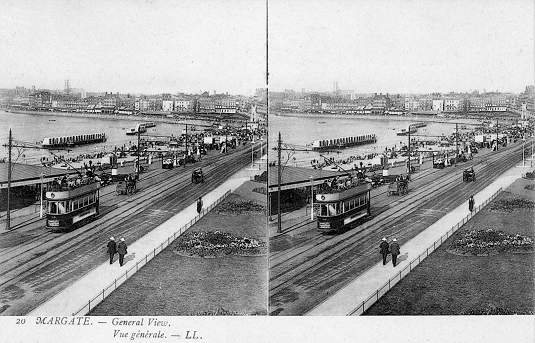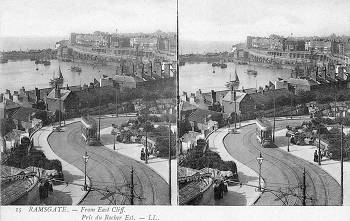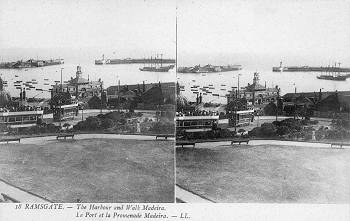

The LL at the end of the title tells us that this postcard of Margate comes from French card producers, Lévy Fils et Cie, of 44 Rue Letellier, Paris. It is number 20 in a series of stereoscopic views of Margate produced in 1904, mainly for the French market. Note the bilingual captions. Bathing machines can be seen actually in the sea, a Victorian phenomenon, which by this date was starting to go out of fashion with most 'machines' being converted into changing huts. From a sister series of stereoscopic postcards, the two smaller pictures below are both of Ramsgate, card 15 from East Cliff and card 18 showing the Harbour and Madeira Walk.
 The Isle of Thanet Electric Tramways & Lighting Co. Ltd. was described with our postcard showing the accident in 1905 to car 41 (see Postcard). Car 30 in our main postcard was originally one of twenty reversed maximum-traction bogie cars (numbered 21-40, 1-20 were similar 4-wheelers) built for the opening of the line in 1900 by the St. Louis Car Co. of the United States and delivered in 1901 in "kit" form. After a run away in 1901, the Board of Trade had insisted that all Thanet cars were fitted with track brakes. The 4-wheelers were easily dealt with, but it was not possible with the bogie cars, so the company designed and fitted their own rather crude "scotch" brakes. On 12th August 1903 one of these cars ran away and collided with another tram injuring 30 people. The Board of Trade blamed the brakes and the bogie cars were withdrawn. The company decided to rebuild them as 4-wheelers, shortening the original six window bodies to an odd 4½ window design and fitting them on Brush AA trucks with B.E.C. track brakes. They each had two General Electric GE58-6T 28 horsepower motors and BTH B18 controllers. The trucks were ordered in April 1904 and the conversions took place in the summer of that year. As rebuilt they seated 24 inside and 30 on top, and it is this form that car 30 in our view can be seen "just out of the works".
The Isle of Thanet Electric Tramways & Lighting Co. Ltd. was described with our postcard showing the accident in 1905 to car 41 (see Postcard). Car 30 in our main postcard was originally one of twenty reversed maximum-traction bogie cars (numbered 21-40, 1-20 were similar 4-wheelers) built for the opening of the line in 1900 by the St. Louis Car Co. of the United States and delivered in 1901 in "kit" form. After a run away in 1901, the Board of Trade had insisted that all Thanet cars were fitted with track brakes. The 4-wheelers were easily dealt with, but it was not possible with the bogie cars, so the company designed and fitted their own rather crude "scotch" brakes. On 12th August 1903 one of these cars ran away and collided with another tram injuring 30 people. The Board of Trade blamed the brakes and the bogie cars were withdrawn. The company decided to rebuild them as 4-wheelers, shortening the original six window bodies to an odd 4½ window design and fitting them on Brush AA trucks with B.E.C. track brakes. They each had two General Electric GE58-6T 28 horsepower motors and BTH B18 controllers. The trucks were ordered in April 1904 and the conversions took place in the summer of that year. As rebuilt they seated 24 inside and 30 on top, and it is this form that car 30 in our view can be seen "just out of the works".
 Stereoscopic pictures, the stereo pair, allow the viewer to see a view that appears solid and in three dimensions i.e. 3D. On viewing a scene the image from your left eye is slightly different to that from your right eye, an effect known as parallax. Your brain puts the two images together and interprets the differences to determine the size and relative location of the objects seen. The stereo pair is produced either in a special camera with two lenses or two cameras fixed together on a bracket, giving two simultaneous images taken from the slightly different positions that correspond to the distance between our eyes. (If the two cameras are moved further apart, the effect is accentuated, a technique used in aerial reconnaissance). The resulting pictures are looked at through a viewer that usually has two convex magnifying lenses and is arranged so the left eye only sees the left-hand picture and similarly the right eye only sees the right-hand picture. The brain puts them together and the picture looks solid and in 3D. In fact although M. Lévy produced excellent postcards, his stereo pairs could be better. For the most dramatic effect you need a bold object close in the foreground so that it "jumps" out of the picture. These landscapes, the Lévy speciality, are not the best subjects for stereoscopic photography.
Stereoscopic pictures, the stereo pair, allow the viewer to see a view that appears solid and in three dimensions i.e. 3D. On viewing a scene the image from your left eye is slightly different to that from your right eye, an effect known as parallax. Your brain puts the two images together and interprets the differences to determine the size and relative location of the objects seen. The stereo pair is produced either in a special camera with two lenses or two cameras fixed together on a bracket, giving two simultaneous images taken from the slightly different positions that correspond to the distance between our eyes. (If the two cameras are moved further apart, the effect is accentuated, a technique used in aerial reconnaissance). The resulting pictures are looked at through a viewer that usually has two convex magnifying lenses and is arranged so the left eye only sees the left-hand picture and similarly the right eye only sees the right-hand picture. The brain puts them together and the picture looks solid and in 3D. In fact although M. Lévy produced excellent postcards, his stereo pairs could be better. For the most dramatic effect you need a bold object close in the foreground so that it "jumps" out of the picture. These landscapes, the Lévy speciality, are not the best subjects for stereoscopic photography.
![]() Go to Postcard Of The Month Index
Go to Postcard Of The Month Index